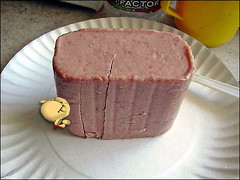Home / Inmates and Prisons

The Justice Department’s Bureau of Justice Statistics (BJS) released its latest report on the inmate population in America's jails and prisons. The headline spins "Slower Growth..." The reality: Our prison population increased once again, and we now have 2.3 million in our nation's prisons and jails.
The report is available here. Chief findings, according to the DOJ press release:
- Between January and June 2007, the prison population increased by 1.6% (or 24,919 prisoners), compared to a 2% increase during the first six months of 2006.
- The number of prisoners sentenced to more than 1 year increased 1.7% between December 31, 2006 and June 30, 2007, or at about the same rate as the total number of prisoners under jurisdiction.
- Between 2000 and 2007, the number of inmates in custody in prisons or jails increased by 367,200. Male inmates (315,100) accounted for 86% of the increase to the custody population. Female inmates (52,100) made up the remaining 14%.
(6 comments) Permalink :: Comments
Back in the day of chain gangs, Alabama passed a law that gave sheriffs $1.75 a day to feed each prisoner in their jails, and the sheriffs got to pocket anything that was left over. More than 80 years later, most Alabama counties still operate under this system, with the same $1.75-a-day allowance, and some sheriffs are actually making money on top of their salaries. ...Critics charge that Alabama is, in effect, paying law enforcement to skimp on food and may be rewarding sheriffs for mistreating prisoners.
"Critics charge"? We should all be critical of laws that reward the mistreatment of prisoners. Does anybody out there think this is sound public policy? (more...)
(22 comments, 439 words in story) There's More :: Permalink :: Comments
The Washington Post has conducted an investigation into medical care at U.S. detention centers housing immigration violators. Its conclusion:
Some 83 detainees have died in, or soon after, custody during the past five years. The deaths are the loudest alarms about a system teetering on collapse. Actions taken -- or not taken -- by medical staff members may have contributed to 30 of those deaths, according to confidential internal reviews and the opinions of medical experts who reviewed some death files for The Post.
According to an analysis by The Post, most of the people who died were young. Thirty-two of the detainees were younger than 40, and only six were 70 or older. The deaths took place at dozens of sites across the country. The most at one location was six at the San Pedro compound near Los Angeles.
More...
(19 comments, 584 words in story) There's More :: Permalink :: Comments
I frequently write about the need to be smarter, rather than just tough on crime. That means funding prison programs that rehabilitate prisoners and reduce the chance of recidivism.
Here's a success story. On May 26, among those wearing a cap and gown to receive degrees at the University of Colorado in Colorado Springs will be Alex Matheson.
Matheson, a twice-convicted felon, has earned degrees in English and Philosophy. Now 26, Matheson's first crime stint landed him in Colorado's youth correctional facility. He escaped, and ended up at the Crowley Correctional Facility.
More...
(11 comments, 433 words in story) There's More :: Permalink :: Comments
More essential reading from Adam Liptak -- the lead paragraph says it all:
The United States has less than 5 percent of the world’s population. But it has almost a quarter of the world’s prisoners.
The U.S. leads the world in imprisoning its population: 751 people are in prison for every 100,000 in the population. Russia comes in second, with 627 out of 100,000 behind bars. The numbers for England and Germany are 151 and 88 per 100,000, respectively. Why are the U.S. numbers so high?
Americans are locked up for crimes — from writing bad checks to using drugs — that would rarely produce prison sentences in other countries. And in particular they are kept incarcerated far longer than prisoners in other nations.
How is America's "lock 'em up" mentality perceived in the rest of the world? (more ...)
(45 comments, 512 words in story) There's More :: Permalink :: Comments

Arguments in Inmates vs. Nutraloaf (not the real case name but the court's website is down and I can't find the real one)will be heard tomorrow by the Vermont Supreme Court. It's a class action case brought by inmates to halt the practice of feeding nutraloaf as punishment to prisoners who misbehave.
When shooting suspect Christopher Williams acted up in prison, he was given nutraloaf — a mixture of cubed whole wheat bread, nondairy cheese, raw carrots, spinach, seedless raisins, beans, vegetable oil, tomato paste, powdered milk and dehydrated potato flakes. Prison officials call it a complete meal. Inmates say it's so awful they'd rather go hungry.
Here's a recipe for Nutraloaf: [more]
(31 comments, 265 words in story) There's More :: Permalink :: Comments
The New York Times has an editorial today on the report released by the Pew Center last week and its statistics showing that 1 in every 100 Americans are in jail or prison.
The Times advocates the passage of the Second Chance Act (S. 1060: Recidivism Reduction and Second Chance Act of 2007). The bill would expand services to offenders and their families for reentry into society. In addition, it would:
Direct the Attorney General to award grants for: (1) state and local reentry courts; (2) Comprehensive and Continuous Offender Reentry Task Forces; (3) pharmacological drug treatment services to incarcerated offenders; (4) technology career training for offenders; and (5) mentoring services for reintegrating offenders into the community.
.... [and] Require the Director of the Bureau of Prisons to establish: (1) a prisoner reentry program; and (2) a pilot program for the release of elderly nonviolent offenders (age 60 or older).
Both Hillary Clinton and Barack Obama have signed as co-sponsors. The bill passed on the House side by a vote 347-62. So who's holding it up in the Senate?
It was Sen. Jeff Sessions (R-AL) who, concerned about the cost, said he needed more time to study it. The bill is now sitting in the Senate Judiciary Committee. Let's get it passed.
(7 comments) Permalink :: Comments
Consider this:
With more than 2.3 million people behind bars at the start of 2008, the United States leads the world in both the number and the percentage of residents it incarcerates, leaving even far more populous China a distant second, noted the report by the nonpartisan Pew Center on the States.
Before you start chanting "We're number 1," consider the cost of living in Prison Nation:
More than one in 100 adults Americans is in jail or prison, an all-time high that is costing state governments nearly $50 billion a year, in addition to more than $5 billion spent by the federal government, according to a report released today.
If you're thinking "there must be a better way," you're right:
(20 comments, 629 words in story) There's More :: Permalink :: Comments

The New York Times has an article today on communities that feed off the prisons within them. When America, prison nation, closes one of them, it can threaten the very existence of such towns.
As rural economies across the country crumbled in the 1980s and the population of prison inmates swelled, largely because of tougher drug laws, states pushed prison construction as an economic escape route of sorts. Throughout the 1960s and ’70s, an average of four prisons were built each year in rural America; the rate quadrupled in the 1980s and reached 24 a year in the 1990s, according to the federal Agriculture Department’s economic research service. The boom, experts say, provided employment, but it also fostered a cycle of dependency.
Count me among those with no sympathy. America's over-incarceration policies mean corporations make billions and the federal government throws millions to these communities in subsidies.
Take the town in the article, Gabriels, New York, which has a prison recently ordered closed by Gov. Spitzer. [More...]
(15 comments, 791 words in story) There's More :: Permalink :: Comments
Attorney General Michael Mukasey has announced the Bush Administration will give $200 million to state and local governments to fight crime. Among his reasons:
Mukasey also rapped U.S. Sentencing Commission plans to allow some 19,500 federal prison inmates, most of them black, to seek reductions in their crack cocaine sentences. The attorney general described many of the inmates as violent gang members who could threaten public safety if released sooner than initially expected.
"A sudden influx of criminals from federal prison into your communities could lead to a surge in new victims as a tragic but predictable result," Mukasey told the mayors.
Only a small percentage of those 19,500 inmates will get any benefit from the change. For those that do, in most cases, the average sentence reduction is expected to be about 16 months. Many of those serving these draconian sentences are not violent criminals but drug offenders unlucky enough to have been caught possessing or selling the wrong drug.
Bush and Mukasey should have put the $200 million into drug treatment and offender re-entry programs. It would be far better spent and of greater ultimate benefit both to the inmates being released and the communities that receive them.
I guess this shows Mukasey, like Bush, intends to continue to be tough rather than smart about crime. [More....]
(9 comments, 275 words in story) There's More :: Permalink :: Comments

Calling George Orwell.
The Independent (UK) reports:
Ministers are planning to implant "machine-readable" microchips under the skin of thousands of offenders as part of an expansion of the electronic tagging scheme that would create more space in British jails. Amid concerns about the security of existing tagging systems and prison overcrowding, the Ministry of Justice is investigating the use of satellite and radio-wave technology to monitor criminals.
But, instead of being contained in bracelets worn around the ankle, the tiny chips would be surgically inserted under the skin of offenders in the community, to help enforce home curfews.The tags, labelled "spychips" by privacy campaigners, are already used around the world to keep track of dogs, cats, cattle and airport luggage, but there is no record of the technology being used to monitor offenders in the community. The chips are also being considered as a method of helping to keep order within prisons.
Civil liberties groups and probation officers in Britain are outraged. [More...]
(5 comments, 456 words in story) There's More :: Permalink :: Comments
This sounds like a prelude to a scene out of "I am Legend" where Will Smith is the last man alive after a virus breaks out. Only it's real, and it's happening in California prisons.
In the past three years, more than 900 inmates at the prison have contracted [Valley] fever, a fungal infection that has been both widespread and lethal. At least a dozen inmates here in Central California have died from the disease, which is on the rise in other Western states, including Arizona, where the health department declared an epidemic after more than 5,500 cases were reported in 2006, including 33 deaths.
It's not just inmates who are contracting Valley Fever which appears to be spread through soil in areas of the Southwest.
More...
(9 comments, 545 words in story) There's More :: Permalink :: Comments
| << Previous 12 | Next 12 >> |







